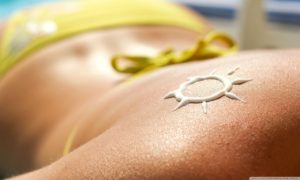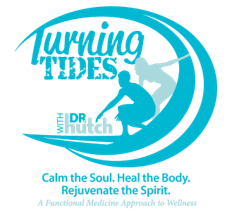Did you know vitamin D is actually not a vitamin, but a hormone? Yep! That’s right! Vitamin D is not a vitamin or a nutrient, it is a hormone produced by the body in the skin from a photolytic reaction with ultraviolet light. Many people who chose not to go in the sun or perhaps they live in an environment where the sunshine is not always readily available to them throughout the year they can take a vitamin D supplement, preferably and most definitely recommended as vitamin D3 (Cholecalciferol). D3 is made by the body in response to sun exposure; therefore it is the most useful form of D3 to the body. This form is also important to make sure it is absorbed adequately; therefore I would suggest a supplemental form of vitamin D3 in addition to adequate unprotected sun exposure. I prefer liquid vitamin D3 from a reputable source. However, for those who are able and desire to bask in the SunShine, like me, be sure to not burn your skin. Note: Sunburned skin causes skin cancer.
 I LOVE the SunShine and I have to admit one of my favorite things in the world is to see the sunrise and sunset. It truly can be a breathtaking experience. I love it when it is HOT!!! I would never make it living in the north. We’ve lived in Virginia Beach for some time, and I would not trade it for the world, but I’m thankful we live in the SunShine state of Florid now. In Va Bch, we had many hot and wonderful days, but those months in the winter – way too much for me to handle. Being able to spend time at the beach pretty much all year around is most certainly a dream come true for me. I thought by the amount of time I spend outdoors that my vitamin D levels were fine, but I had never had my vitamin D levels checked until the fall of last year (2016), and even mine was low at this time. I was shocked to see how low, but I was not spending as much time in the sun as I typically do. So, lesson learned for me. This is important because insufficient vitamin D levels are known to be at the root of many diagnoses, from depression to cancer. Ultimately, with or without sun exposure many of us continue to be deficient. It is suggested to have your vitamin D level checked periodically. There are many reasons why someone can be deficient, so don’t assume you are not.
I LOVE the SunShine and I have to admit one of my favorite things in the world is to see the sunrise and sunset. It truly can be a breathtaking experience. I love it when it is HOT!!! I would never make it living in the north. We’ve lived in Virginia Beach for some time, and I would not trade it for the world, but I’m thankful we live in the SunShine state of Florid now. In Va Bch, we had many hot and wonderful days, but those months in the winter – way too much for me to handle. Being able to spend time at the beach pretty much all year around is most certainly a dream come true for me. I thought by the amount of time I spend outdoors that my vitamin D levels were fine, but I had never had my vitamin D levels checked until the fall of last year (2016), and even mine was low at this time. I was shocked to see how low, but I was not spending as much time in the sun as I typically do. So, lesson learned for me. This is important because insufficient vitamin D levels are known to be at the root of many diagnoses, from depression to cancer. Ultimately, with or without sun exposure many of us continue to be deficient. It is suggested to have your vitamin D level checked periodically. There are many reasons why someone can be deficient, so don’t assume you are not.
“A major source of vitamin D for most people comes from exposure of the skin to sunlight typically between 1000 h and 1500 h in the spring, summer, and fall. Vitamin D produced in the skin may last at least twice as long in the blood compared with ingesting vitamin D. When an adult has bathing suit exposure to the sun at one minimal erythemal dose of UV radiation (slight pinkness to the skin 24 h after exposure), the amount of vitamin D produced is equivalent to ingesting between 10,000 and 25,000 IUs of vitamin D3.”[i]
I believe this is about 15 to 20 minutes of unprotected direct sun light. Per the Alliance for Natural Health website, they state, “If you are dark skinned you may need up to 6 times longer sun exposure to achieve the same results.”[ii]
It is thought the more time you spend in the SunShine loving up on the solar UV exposure at regular intervals the body will gradually adapt to the increasing and decreasing UV doses. However, sun burning should be avoided, but the best time for exposure should be in the middle of the day when the UVB to UVA ratio is the highest and for the best results.[iii]
A little touch on cancer and sun exposure
This post is not about the sun and its damage it can cause regarding skin cancers, but I think it is a relevant topic to touch on. It is not a big secret that UV rays from the sun can most certainly cause sun damage and some skin cancers and non-cancerous tumors. However, per one article there is mounting evidence that sun exposure is not all bad and can help with protecting against a wide range of diseases, such as depression to autoimmune diseases to cardiovascular to asthma, and obesity just to name a few. In addition, there is a link between sun exposure and its protective mechanisms in some cancer types, but not all cancers. This same article stated, “Sunseeking women are significantly less likely to die from cardiovascular disease and non-cancer disease. Ironically, this study showed women with active sunlight exposure habits lived longer and so more of them died of cancer. Many patients burdened with cancer do have low circulating vitamin D levels. This has led some to conclude low vitamin D levels are the cause, rather than the consequence of cancer. Researchers simply do not know for sure if some of the protective effects of the sun are due to UV production of the active form of vitamin D, or some other pathway activated by UV that explains sunlight protection.[iv]
The Low-Down on commercial sun-products
 Be aware, just like anything else in life anything can have benefits as well as its problems. Therefore my job as a practitioner and one who loves and advocates spending time in the SunShine it is my obligation to help support those who love and desire to be in the sun as much as I do. We are excited to be working on a sun protective product that is both safe for our family, clients and the ocean and its surroundings. Being able to provide a natural product is something we’ve considered for a long time. We’ve tried many organic ones on the market currently and find them to be thick and hard to spread and soak into the skin. So, it is our hope to create one that is going to be spreadable, soakable and one that is going to deliver a layer of protection needed for those of us who love to enjoy the SunShine often and for long periods of time. My issue with the current mainstream products on the market is that so many people use these products because they desire to “protect” themselves from the “harmful” conditions that come along with sunbathing, but in reality, these concoctions are in fact more harmful in my opinion with all of the chemical derived ingredients. On the Environmental Working Group web site they address some of the ingredients found in many commercial products today.
Be aware, just like anything else in life anything can have benefits as well as its problems. Therefore my job as a practitioner and one who loves and advocates spending time in the SunShine it is my obligation to help support those who love and desire to be in the sun as much as I do. We are excited to be working on a sun protective product that is both safe for our family, clients and the ocean and its surroundings. Being able to provide a natural product is something we’ve considered for a long time. We’ve tried many organic ones on the market currently and find them to be thick and hard to spread and soak into the skin. So, it is our hope to create one that is going to be spreadable, soakable and one that is going to deliver a layer of protection needed for those of us who love to enjoy the SunShine often and for long periods of time. My issue with the current mainstream products on the market is that so many people use these products because they desire to “protect” themselves from the “harmful” conditions that come along with sunbathing, but in reality, these concoctions are in fact more harmful in my opinion with all of the chemical derived ingredients. On the Environmental Working Group web site they address some of the ingredients found in many commercial products today.
“Commonly used ingredients are called “penetration enhancers” and help to product adhere to the skin. As a result, these chemicals are absorbed into the body and can be measured in blood, breast milk, and urine samples. The most common products contain chemical filters. These products typically contain two to six of the following active ingredients: oxybenzone, avobenzone, ostisalate, octocrylene, homosalate and octinoxate. Laboratory studies indicate that some chemical UV filters may mimic hormones and sunscreen-related skin allergies. Furthermore, the Food and Drug Administration (FDA) has not reviewed evidence of potential hazards of sunscreen filters –instead it grandfathered in ingredients used in the late 1970s. In addition, the article pointed out some of these chemical filters interacts with human sex or thyroid hormones. It appears the most worrisome in the ingredient list is oxybenzone. In laboratory studies oxybenzone is a weak estrogen and has potent anti-androgenic effects. It was found that adolescent boys and men with higher oxybenzone measurements had significantly lower total testosterone levels.”[v]
And if that’s not bad enough most SunShine lovers are slathering themselves in these toxic chemicals from head to toe. And then there is the spray-ons. The spray-ons present an additional layer of concern as they spray themselves down they’re also breathing in these carcinogens right into their respiratory system and ultimately reaching other organs too. And unfortunately mine too; if I find my-self close enough to them. These chemicals seriously take my breath away when being sprayed. I also think about the poor sea creatures and how they may be affected by these poisons and of course the kids that are being slathered from head to toe too. My favorite is when these little ones get sprayed in the face. Oh, my goodness!! Please, at least spray in your hand and then apply to the face and body. In the mean time, keep a watchful eye out for our product to make its debut next summer. Until then use protection, but be smart and choose one that is safe for you, your family and the environment.
Vitamin D benefits: It does the body and brain good
As you may imagine vitamin D has a vast number of ways it is needed to help support the body and brain. One of these is through sunlight as we have already been discussing. Sunlight also affects the production of serotonin, an important neurotransmitter located in the gut and brain, mostly in the gut. Being exposed to the SunShine is a vital piece to help with combating depression and Alzheimer’s disease. Serotonin deficiencies have been linked to both in multiple studies. [vi] Many people of all ages can have insufficiencies in many of the neurotransmitters and serotonin often leads the way. It is a critical neurotransmitter that plays a part in many body functions. Serotonin is not only an important neurotransmitter in brain function, but it is also needed for movement of the bowels. You actually have more serotonin in the gut than there is in the brain. Therefore an inadequate serotonin level can also contribute to constipation. I bet you didn’t expect to see the topic of gut health in a vitamin D post. When this marker is low we typically see symptoms of depression. Someone experiencing a reduced serotonergic activity can be associated with impulsive behavior. To be clear, vitamin D does not produce serotonin itself, but vitamin D, which is a hormone, does help in the release of neurotransmitters, such as serotonin. The tie in with the SunShine and the production of serotonin can be found in the principles that light and darkness can cause activation and release of neurotransmitters. When the sun goes down generally there should be an increase in melatonin.
Beneficial foods & Supplements for added UV exposure protection:
I‘m going to wrap this post up with some beneficial foods that can help provide some protection from the sun too, such as herbs and whole food choices. One key factor in choosing the right foods for protection is their antioxidant activity. In one article I found on the topic the researcher states, “although isolated plant compounds have a high potential in the protection of the skin, whole herb extracts showed better potential due to their complex composition.[vii] I think the most advantageous way for me to provide this information in a quick reference for you is to list each one out separately. Furthermore, “In order to protect the skin against sunlight in the prevention of photocarcinogenesis. Although nature increases epidermal thickness, stimulating melanogenesis, and providing natural antioxidants in the superficial skin layers, supplementation with nutrients may support these processes and serve as an additional layer of protection against harmful effects of UV light.”[viii] The list below should not be considered a comprehensive one; it is only to serve as a starting point.
Nutrients to protect against UV rays: before and after sun exposure
- Green and black tea (polyphenols) ameliorate (make something bad better) adverse skin reactions to UV exposure.
- Aloe is believed to stimulate skin and assist in new cell growth.
- Cyanidin found in various fruit sources such as grapes, cranberry, elderberry, bilberry, cherry, blueberry and blackberries function as a powerful antioxidant, additional studies have confirmed that cyaniding is four times more powerful antioxidant than vitamin E.
- Eggplant contains a derivative from anthocyanidin delphinidin called nasunin, this substance is known to interfere with free radical damage
- Fresh fruits and vegetables will add the needed antioxidants to help support the immune system and enhance protection of the sun.
- Vitamin C and vitamin E have both been studied for decades showing supplementation with vitamins resulted in an additional reduction of the number of sunburn cells.vi
- Presupplementation with moderate dosages of 30mg β-carotene before and during sunlight provides protection against sunburn.vi
- Fish oils – dietary supplementation with EPA was shown to protect the skin both at the macroscopic and cellular levels, despite an increase in oxidative stress.vi
- Life Extension magazine shares recent studies with astaxanthin and how it can rejuvenate skin from within. This powerful antioxidant is 1,000 times more powerful than vitamin E and has a greater ability to scavenge skin-damaged free radicals. It has the ability to accumulate in the skin, more so than the other organs in the body, where it can provide potent protection against ultraviolet radiation. [ix]
OILS & Essential oils that offer UV protection:
| Name of herbal oil taken | SPF value calculated *Spectrophotometry |
| Olive oil | 7.549 |
| Coconut oil | 7.119 |
| Castor oil | 5.687 |
| Almond oil | 4.659 |
| Mustard oil | 2.105 |
| Chaulmoogra oil | 2.019 |
| Sesame oil | 1.771 |
| Peppermint oil | 6.668 |
| Tulsi oil | 6.571 |
| Lemon grass oil | 5.624 |
| Orange oil | 3.975 |
| Lemon oil | 2.810 |
| Eucalyptus oil | 2.625 |
| Tea tree oil | 1.702 |
| Rose oil | 0.248 |
| *Spectrophotometry calculated sun protection factor of herbal oils.[x]
Note: To develop sunscreens with better safety and high SPF, the formulator must understand the physicochemical principle, not only the UV absorbance of the actives. Disclosure: It is not recommended to formulate your own sunscreen at home with this information. This information is being provided for educational purposes only. |
|
| Almond oil | Topical application of cream formulation has significant antioxidant and anti-photo aging properties |
| African tulip tree | The results revealed in this plant confirmed this is a better and safe alternative to harmful chemical sunscreens |
| Shea butter | Cinnamic acidin the oil provides vital protection against harmful UV rays |
| Jojoba oil | Provides some protection, offering a low SPF of 4 |
| Carrot seed oil | Have a natural SPF of 38 and 40 |
| Evening primrose oil | Soothes skin problems and inflammation. It discourages dry skin and premature aging of the skin [xi] |
Topical Treatments:
- Vitamin D (inhibits skin cell proliferation and modulates immune cell)[xii]
- Aloe Vera ( the kind from the plant, not out of the bottle with other harmful ingredients)viii
- Capsaicin cream (helps with pain impulses)viii
- Curcumin cream (anti-inflammatory agent)viii
- Green tea in an extract, or used as tea leaves and bags can help sooth sunburn[xiii]
- Peppermint with its menthol properties has been known to sooth sunburnsix and to help cool down when overheated.
- Vitamin C protects skin from sunburns. ix
- Witch Hazel with its astringents properties this choice is wonderful in relieving sunburn pain. ix
[i] Holick, M. F., Binkley N.C., Bischoff-Ferrari, H. A., Gordon, C. M., Hanley, D. A., Heaney, R. P., Murad, M. H., & Weaver, C. M: (2011). Evaluation, Treatment, and Prevention of vitamin D deficiency: an Endocrine Society clinical practice guideline.Journal of Clinical Endocrinal Metabolism.96 (12):3980. Doi:10.1210/jc.2011-0385 Evaluation, treatment, and prevention of vitamin D deficiency: an Endocrine Society clinical practice guideline. – PubMed – NCBI
[ii] http://anhinternational.org/2017/08/16/vitamin-d-prevention-rather-cure Vitamin D – Prevention rather than cure: Are you getting enough? Vitamin D that is! Retrieved August 28, 2017.
[iii] Vitamin D Council | Health benefits of sun exposure: vitamin D and beyond Retrieved from: The Vitamin D Council August 15, 2017
[iv] Marshall, J. E., & Byrne, S. N. (2017). Does sunlight protect us from cancer? Royal Society of Chemistry16:416-425. Retrieved from: Does sunlight protect us from cancer? – PubMed – NCBI August 15, 2017
[v] Environmental Working Group web site. The trouble with ingredients in sunscreens (ND). Retrieved from: The Trouble With Ingredients in Sunscreens | EWG’s 2017 Guide to Sunscreens August 29, 2017.
[vi] Grant, W. (2017). Health benefits of sun exposure: vitamin D and beyond. The B+Vitamin D Council Blog & Newsletter. Retrieved from: Vitamin D Council | Health benefits of sun exposure: vitamin D and beyond August 15, 2017
[vii] Korac, R. R., & Khambholja, K. M. (2011)Potential of herbs in skin protection from ultraviolet raditation. Pharacogosy Reviews10(5): 164-173.Retrieved from:Potential of herbs in skin protection from ultraviolet radiation August 15, 2017
[viii] Boelsma, E., Hendriks, H.F.J., & Roza L. (2001). Nutritional skin care: health effects of micronutrients and fatty acids. The American Journal of Clinical Nutrition73(5):853-864.review article.Nutritional skin care: health effects of micronutrients and fatty acids: EBSCOhost
[ix] Hawkins, L. (2013). Astaxanthin provides broad spectrum protection. Retrieved from:Astaxanthin Protection | Life Extension Magazine August 15, 2017
[x] Kaur,C.,D., & Saraf, S.(2010). In vitro sun protection factor determination of herbal oils used in cosmetics. Pharmacognosy Research, 2(1), 22-25. http://doi.org/10.4103/0974-8490.60586 Retrieved August 29, 2017
[xi] Goswami, P. K., Samant, M., & Srivastava, R. (2013). Natural sunscreen agents: A review. Scholars Academic and Scientific publisher.2(6):458-463. http://saspublisher.com/wp-content/uploads/2013/11/SAJP26458-463.pdf
[xii] Murray, M. T., & Pizzorno, J.(2012). The Encyclopedia of Natural Medicine 3rd.ed. Atria Paperback. New York: NY.pp.927-29
[xiii] O’Mathuna, D., & Larimore, W. (2007). Alternative medicine: the options, the claims, the evidence, how to choose wisely. Zondervan, Grand Rapids: MI pp.370,420,461,473.

